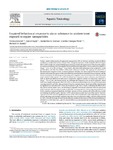Impaired behavioural response to alarm substance in rainbow trout exposed to copper nanoparticles.
| dc.contributor.author | Sovová, T | |
| dc.contributor.author | Kostenko, Natalia | |
| dc.contributor.author | Sloman, KA | |
| dc.contributor.author | Vanegas Pérez, C | |
| dc.contributor.author | Handy, Richard | |
| dc.date.accessioned | 2016-06-22T16:03:59Z | |
| dc.date.available | 2016-06-22T16:03:59Z | |
| dc.date.issued | 2014-04-13 | |
| dc.identifier.issn | 0166-445X | |
| dc.identifier.issn | 1879-1514 | |
| dc.identifier.uri | http://hdl.handle.net/10026.1/4947 | |
| dc.description | RCUK OA article = NE/G0018182/1 | |
| dc.description.abstract |
To date, studies of the toxicity of engineered nanoparticles (NPs) in fish have not fully considered effects on olfactory-mediated behaviours, despite their ecological importance. In this study the effects of copper NPs (Cu NPs) on the anti-predator behavioural responses of juvenile rainbow trout (Oncorhynchus mykiss) to trout alarm substance was investigated. Individual fish were exposed for 12h to a control (no added Cu), 50μgl(-1) of Cu as Cu NPs, or 50μgl(-1) Cu as CuSO4, after which fish behaviours were analyzed in 10min periods before and after the addition of the alarm substance stimulus. The response of control fish to deionised water (negative control, no alarm substance stimulus) was also analyzed. The alarm substance elicited a behavioural response in the control fish characterized by an immediate freeze response and the slower resumption of swimming activity compared to negative controls exposed to the sham deionised water stimuli. In fish exposed to Cu NPs, the behavioural response to alarm substance was eliminated, with no significant difference in behaviours compared to negative controls. In comparison, exposure to 50μgl(-1) Cu as CuSO4 decreased, but did not eliminate the response of fish to alarm substance, which indicated a significantly greater effect of Cu NPs on olfactory mediated behaviours than of the equivalent concentration of Cu as CuSO4. Measurement of total Cu concentrations in the tissues of fish demonstrated no significant accumulation of Cu from any treatment in gill, liver or brain, confirming the effects of Cu NPs, and to a lesser extent CuSO4, on behavioural responses were mostly associated with the interaction of the materials with the external surfaces of the fish. Scanning electron microscopy revealed that Cu as CuSO4 caused a pronounced depletion of ciliated sensory and non-sensory cells in the olfactory rosette surrounding the midline raphe, whereas Cu NPs had no impact on the structure of the rosette. However, exposure to Cu NPs caused a significant increase in the ratio of oxidized to reduced glutathione in brains of fish, indicating some systemic oxidative stress that was not observed in either controls or fish exposed to CuSO4. Overall, the study showed that the olfactory mediated behaviours of fish were potentially more sensitive to Cu NPs than CuSO4 and NPs elicited effects via a mechanism that is distinct from that of the metal salt. | |
| dc.format.extent | 195-204 | |
| dc.format.medium | Print-Electronic | |
| dc.language | ENG | |
| dc.language.iso | ENG | |
| dc.publisher | Elsevier BV | |
| dc.subject | Alarm substance | |
| dc.subject | Copper | |
| dc.subject | Fish behaviours | |
| dc.subject | Nanomaterials | |
| dc.subject | Olfaction | |
| dc.subject | Rainbow trout | |
| dc.title | Impaired behavioural response to alarm substance in rainbow trout exposed to copper nanoparticles. | |
| dc.type | journal-article | |
| dc.type | Article | |
| plymouth.author-url | http://www.ncbi.nlm.nih.gov/pubmed/24792150 | |
| plymouth.volume | 152C | |
| plymouth.publication-status | Published | |
| plymouth.journal | Aquat Toxicol | |
| dc.identifier.doi | 10.1016/j.aquatox.2014.04.003 | |
| plymouth.organisational-group | /Plymouth | |
| plymouth.organisational-group | /Plymouth/Faculty of Science and Engineering | |
| plymouth.organisational-group | /Plymouth/Faculty of Science and Engineering/School of Biological and Marine Sciences | |
| plymouth.organisational-group | /Plymouth/REF 2021 Researchers by UoA | |
| plymouth.organisational-group | /Plymouth/REF 2021 Researchers by UoA/UoA06 Agriculture, Veterinary and Food Science | |
| plymouth.organisational-group | /Plymouth/Research Groups | |
| plymouth.organisational-group | /Plymouth/Research Groups/Marine Institute | |
| plymouth.organisational-group | /Plymouth/Users by role | |
| plymouth.organisational-group | /Plymouth/Users by role/Academics | |
| dc.publisher.place | Netherlands | |
| dcterms.dateAccepted | 2014-04-01 | |
| dc.identifier.eissn | 1879-1514 | |
| dc.rights.embargoperiod | Not known | |
| rioxxterms.versionofrecord | 10.1016/j.aquatox.2014.04.003 | |
| rioxxterms.licenseref.uri | http://www.rioxx.net/licenses/all-rights-reserved | |
| rioxxterms.type | Journal Article/Review |


